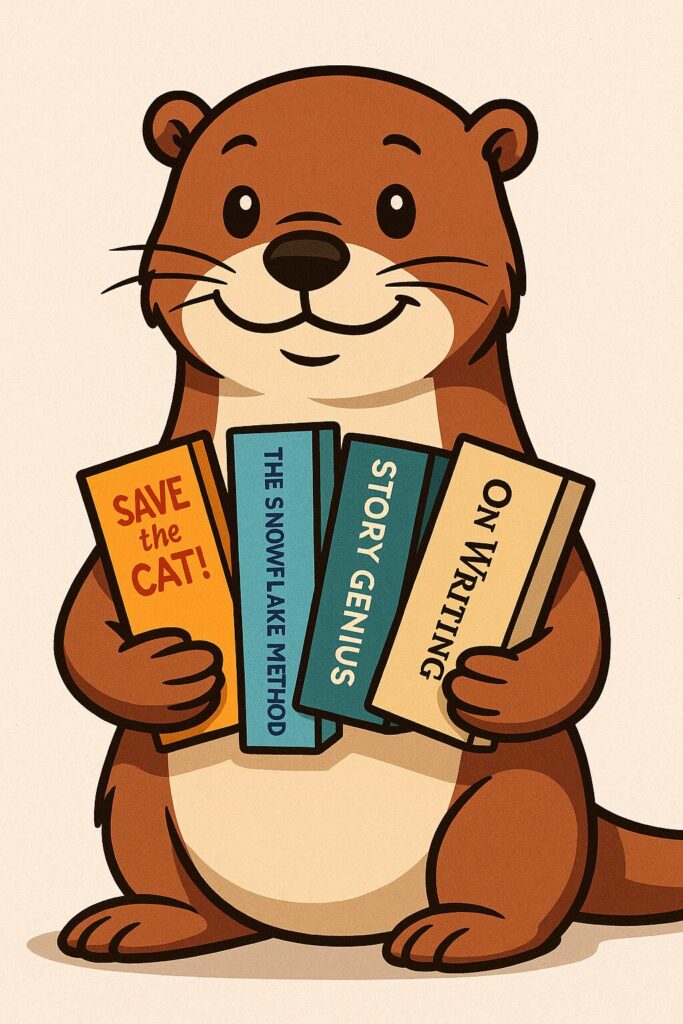from four standout writing books
When you’re just starting out as a writer, the sheer volume of advice can be paralysing. Do you outline or wing it? Start with character or plot? Should you write every day? Should you even bother if you’re not already published?
That’s why I’ve pulled together the core lessons from four writing books I personally recommend — because they each offer something unique, and when combined, they form a toolkit that’s practical, balanced, and actually doable.
Here’s what we can learn from Save The Cat, Story Genius, The Snowflake Method, and On Writing — and how each one can help you become the writer you’re trying to be.
🐱 1. From Save the Cat! by Blake Snyder
Structure isn’t the enemy — it’s the engine.
Snyder’s 15-beat “beat sheet” may come from the world of screenwriting, but it’s become a favourite among novelists for a reason: it gives stories a clear, compelling shape.
What You Can Learn:
- Every story needs a turning point early on — something that kicks the plot into motion (the “Catalyst”).
- Your protagonist should be likeable or at least relatable — hence “Save the Cat.”
- The “Fun and Games” section (Act 2A) is your story’s promise — give the reader what they came for before everything turns dark.
- Knowing the ending before you start can keep your draft on track.
📝 Takeaway for new writers:
Use structure as a skeleton — not a straitjacket. If you don’t know what happens next, a beat sheet can be your flashlight.
🧠 2. From Story Genius by Lisa Cron
What your character believes matters more than what happens.
Where Save the Cat is all about plot points, Story Genius digs into the emotional and psychological heart of storytelling. Cron argues that stories succeed when they’re powered by a deep internal struggle that connects everything that happens to your protagonist’s worldview.
What You Can Learn:
- Start by figuring out your character’s “misbelief” — a false assumption they carry from the past.
- Every scene should challenge, confirm, or unravel that misbelief.
- Don’t just ask what happens — ask why does it matter emotionally?
📝 Takeaway for new writers:
Plot is important — but plot without emotional logic is just a list of events. Make sure your character feels their way through the story.
❄️ 3. From The Snowflake Method by Randy Ingermanson
You can build your novel one layer at a time.
The Snowflake Method is perfect for those who get overwhelmed by the idea of writing 80,000 words in one go. It’s a step-by-step outlining approach that starts with a one-sentence summary and gradually builds to scenes and chapters.
What You Can Learn:
- Start small: a one-sentence idea → a paragraph → a page.
- Expand slowly, layering detail at each step — character arcs, motivations, backstory.
- Writing a synopsis before writing the novel can save hours of rewriting.
📝 Takeaway for new writers:
You don’t have to figure everything out at once. Build your story gradually, the way you’d sketch a landscape before painting it.
✍️ 4. From On Writing by Stephen King
Writing is a craft, not a mystery.
Part memoir, part masterclass, King’s On Writing is a reminder that writing is about showing up and doing the work — even when it’s hard, even when you’re scared.
What You Can Learn:
- Read a lot. Write a lot. That’s it.
- First drafts are for telling yourself the story.
- Don’t wait for inspiration — just get your words down.
- Don’t overcomplicate things — avoid adverbs, use simple language, and cut anything that isn’t serving the story.
📝 Takeaway for new writers:
Show up. Write the words. Then fix them. Writing is a job — one you can actually enjoy if you stop trying to be perfect.
🎯 Final Thoughts: A Blended Approach
Each of these books shines in its own way:
- Save the Cat gives you a roadmap.
- Story Genius gives you the emotional engine.
- The Snowflake Method gives you a system.
- On Writing gives you permission to get messy and human.
The truth is, no one method will work for everyone — but taken together, these approaches give you structure, soul, strategy, and sanity.
So if you’re stuck with a vague idea, an unfinished draft, or a dozen half-hearted attempts — take heart. The tools are out there. You just need the right ones in the right order.
And that’s exactly what Writester is here to help you do.




